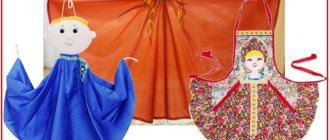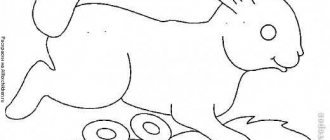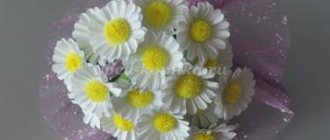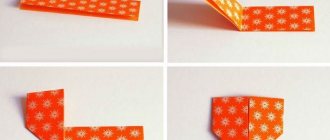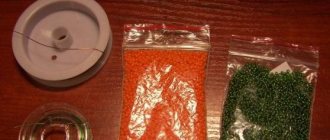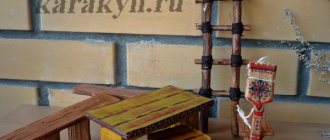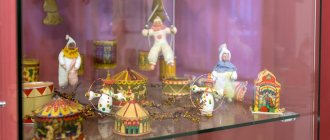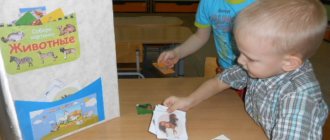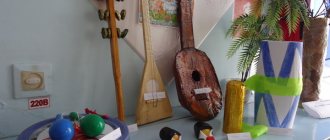Master class “Theater on spoons”
IZMALKINA MARGARITA Master class “Theater on Spoons”
Theatrical activities give the child joy and are one of the most effective methods of correctional influence, in which the principle of learning is most clearly manifested: learn by playing.
During theatrical games:
Children's knowledge about the world around them expands.
Mental processes develop: attention, memory, perception, imagination.
The development of visual, auditory, and speech motor analyzers occurs.
Vocabulary, sound pronunciation, coherent speech skills, expressiveness of speech, and intonation are activated and improved.
Motor skills and coordination of movements are improved.
The emotional-volitional sphere develops. Children get acquainted with the feelings and moods of the characters, and master ways of expressing them externally.
Behavior correction occurs.
The experience of moral behavior develops and is formed.
The development of creative activity and independence is stimulated.
Participation in theatrical games brings joy and arouses active interest.
Goals:
*development of sustainable interest in theatrical activities;
*enrichment and activation of vocabulary;
*improvement of dialogical speech, formation of grammatical structure of speech;
*promoting the manifestation of independence and activity in playing with toy characters.
The main directions of development of theatrical play:
-transition from observing a theatrical performance by an adult to independent play activities;
— the transition from individual play and “side-by-side play” to play in a group of three to five peers playing roles;
— a transition from imitation of the actions of folklore and literary characters to imitation of actions in combination with the transfer of the main emotions of the hero.
Objectives and content of the work
It is necessary to develop an interest in theatrical games, which develops in the process of watching real puppet shows, which are shown by the teacher, taking as a basis the content of nursery rhymes, poems and fairy tales familiar to the child.
It is important to stimulate the child’s desire to join the play by complementing individual phrases in the characters’ dialogues, stable turns of the beginning and ending of the fairy tale.
Glove puppets and other puppets are used in classes, as well as in everyday communication. On behalf of the doll, the adult thanks and praises the children, says hello and goodbye.
The implementation of this task is achieved by successively complicating game tasks and dramatization games in which the child is included.
The shortest way to emotionally liberate a child, relieve tension, teach sensory perception and artistic imagination is the path through play, fantasy, and writing. All this can be achieved through theatrical activities.
Theatrical activities in kindergarten make it possible to solve many pedagogical problems in the formation of the expressiveness of a child’s speech, intellectual and artistic-aesthetic education. It is a source of development of feelings, experiences and emotional discoveries, a way of becoming familiar with spiritual wealth. As a result, the child gets to know the world and learns to express his attitude towards the world of good and evil.
Showing a master class for my colleagues, I was glad to share my work experience. The use of plastic spoons in theatrical activities allows you to quickly prepare the necessary material for work. This does not require large material costs. You can use any available means: plasticine, threads, colored paper, pieces of fabric, etc. Children of older preschool age can also take part in this. Joint activities between an adult and a child help to form trusting relationships between them and have a positive impact on the development of a preschooler. The creative process stimulates the imagination and reveals creative potential. It's an exciting and joyful time
e.
Do-it-yourself spoon theater in kindergarten. Step-by-step master class with photos
Master class of a didactic game for theatrical activities based on the fairy tale “Zayushkina’s Hut” for children 4-7 years old: Alexandrina Tatyana Aleksandrovna, teacher of the State Budgetary Educational Institution “School No. 892” Preschool No. 1, Moscow Master class is designed for teachers and parents Purpose: for theatrical activities in kindergarten and at home Goal: making fairy tale heroes for theatrical activities based on plastic spoons Objectives: • Teach the technology of making fairy tale heroes; • Develop creativity and imagination, fine motor skills; • Foster hard work and accuracy when making crafts
Job description: Play activities are a component of the harmonious all-round development of preschool children. Theater is one of the effective types of play activity in kindergarten. In theatrical activities, children show creative activity, develop abilities, and realize their potential. There are different types of theaters: bench, table, floor, etc. And now non-traditional types are increasingly used: from plates, from capsules from Kinder eggs, on sleeves, on cups, on spoons. Spoon theater is a tabletop type of theatre. As a rule, the basis of tabletop theater is our favorite fairy tales. The children know them very well and love them. Theatrical performances based on fairy tales contribute to the formation of independence, initiative, the ability to distinguish between good and evil, and develop facial expressions, gestures, speech, and communication skills. I propose to make one of the heroes of the fairy tale “Zayushkina’s Hut” for theatrical activities (the rest of the heroes are made by analogy). Such characters will undoubtedly cause delight and surprise in the child. Tools and materials:
- album sheet - fur - scissors - two types of fabric - ruler - simple pencil - threads with a needle - plastic spoon - eyes for needlework - Moment glue - braid - woolen threads
Work progress: Using a ruler, measure the width and length of the pattern and make markings with a piece of soap
Using scissors, cut along the contour
Use a blanket stitch to hem the pattern at the top and bottom.
Sew the side edges of the pattern and jumble the top of the pattern
We draw templates for future patterns on a landscape sheet and cut them out
Transfer the ear and tail templates onto the fur and cut them out
Sew the tail to the back of the pattern
Glue the ears to the back of the spoon
Transfer the eye and nose templates to the fabric and cut them out
Glue the eyes, nose and decorative eyes onto the spoon
We measure and cut two threads from a skein of woolen thread to decorate the mouth, and randomly cut small pieces for the antennae. Glue everything onto a spoon
We put the shirt on the spoon. We wrap the top of the shirt with braid and tie a bow
Our dog is ready
By analogy we make the rest of the fairy tale characters
Later my theater on spoons increased
We recommend watching:
DIY stomp dolls DIY paper hare. Master class with step-by-step photos Crocheted puppet theater. Teremok Summary of the educational situation in the senior group “Making the characters of the cone puppet show
Non-traditional types of theater
In addition to the usual materials for puppet theaters, alternative types can be used.
These can include plastic and wooden spoons. Images of characters are drawn or attached to them. When painting on plastic, you should use acrylic paint. If you have to paint with gouache, it is mixed with a small amount of PVA glue.
Interesting options are made from yogurt jars and plastic bottles. They are covered with colored paper, images of characters are attached and fragments of scenery are added. The results are voluminous mini-stories. Such figures do not require additional decorations and develop children's imagination.
Playing theater is a useful and interesting activity. It improves memory and develops oratory skills. The child learns to retell the text, highlight the main points, not be afraid of public speaking, and parents have the opportunity to discern the child’s talents.
